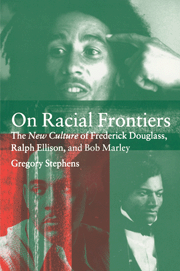The Bondage of Race and the Freedom of Transcendence in Frederick Douglass’s My Bondage and My FreedomPosted in Articles, Literary/Artistic Criticism, Media Archive, Slavery on 2011-10-23 00:08Z by Steven |
Postgraduate English: A Journal and Forum for Postgraduates in English since 2000
Durham University
Issue Number 4 (September 2001)
Briallen Hopper, Lecturer in English
Yale University
Frederick Douglass has a strange way of describing what he feels like when he feels most free. When trying to convey how ardently enthusiastic he was when he first lived among abolitionists, he writes, “For a time I was made to forget that my skin was dark and my hair crisped” (Douglass 366). He echoes this expression of elation and lost self-consciousness when he writes about why he loves living in England: “I meet nothing to remind me of my complexion” (Douglass 374). Douglass was born into a racist society, and it is natural and perhaps inevitable that losing the awareness and memory of his body should be a freeing feeling for him; but when this feeling is described in a work of propaganda so carefully constructed as My Bondage and My Freedom, the reader expects it to be interpreted so as to fit with a larger message that there is nothing intrinsically imprisoning about dark skin and “crisped” hair, and Douglass refuses to interpret it in this way. To Douglass, the feeling of freedom seems to be uncomfortably close to the feeling of being invisible-or white.
I do not pretend to be able to ease the discomfort that Douglass creates in modern readers when he describes the pleasure of losing awareness of his hair and skin, but I believe these readers can understand Douglass better if they read his descriptions of transcendence of race in My Bondage and My Freedom as in part a reaction to the racialist attitudes towards individuals and cultures that prevailed in antebellum culture, including abolitionist culture. In the first two parts of this essay, “‘The African Race Has Peculiarities’: Transcending a Racialized Body,” and “‘A Little of the Plantation Manner’: Transcending a Racialized Culture,” I will describe how the racialism in Harriet Beecher Stowe’s Uncle Tom’s Cabin and in the Garrisonian abolitionists’ expectations for black abolitionists constrained Douglass in a way that was analogous to slavery.
Any attempt to free people from a bondage based on racial identity by an appeal to a liberating discourse which is also based on racial identity is bound to be problematic; as Robyn Wiegman writes, “If identities are not metaphysical, timeless categories of being; if they point not to ontologies but to historical specificities and contingencies; if their mappings of bodies and subjectivities are forms of and not simply resistances to practices of domination-then a politics based on identity must carefully negotiate the risk of reinscribing the logic of the system it hopes to defeat” (Wiegman 6). My claim about My Bondage and My Freedom, put into anachronistic terminology, is that Douglass felt that the politics of racialist abolitionism did not negotiate the risk of reinscription carefully enough; furthermore, he did not believe it was possible for identity politics to avoid reinscribing the logic of slavery.
Douglass’s desire for transcendence was not simply a reaction to racialism. It can also be understood as a positive expression of what he desired for himself and for African-Americans generally: a desire historically described as “assimilationism” and now pejoratively referred to as “universalism” or “bourgeois liberalism”; a desire that is evoked by Martin Luther King’s mythical phrase about children who are judged “by the content of their character rather than the color of their skin.” In the third part of this essay, “‘Race is Transient’: Transcending Race,” I discuss how Douglass, in a strangely postmodernist-yet-universalist way, deconstructs race in order to make assimilation possible. In My Bondage and My Freedom and in countless speeches, Douglass describes the racial self-designations and un-self-designations he makes when traveling on trains (following Douglass’s lead, both the Supreme Court and W.E.B. Du Bois have at times recognized trains to be an ultimate test of the validity of racial identities). These designations and undesignations are breathtaking examples of an American’s willful transcendence of race…
Read the entire essay here.


